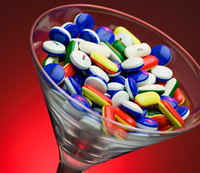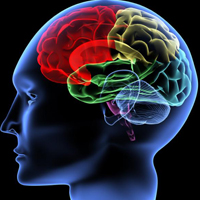Chemotherapy is one of the main methods for the treatment of malignant neoplasms. Polychimotherapy consisting of a rational combination of several chemotherapeutic drugs received the greatest distribution. 7 groups of chemotherapeutic drugs are used in medicine.
Content
Chemotherapy options
Chemotherapy is a method of treating malignant neoplasms with the help of cytotoxic (toxic cells for cells depressing the vital activity of cells) of medicinal substances. Two types of chemotherapy can be used in oncology:
- Monochemotherapy (treatment with one drug)
- Polykhimotherapy (treatment with several drugs at the same time and / or sequentially)
Polykhimotherapy received the greatest distribution. Chemotherapy can be used as the only method of treatment or in combination with other methods - surgical and radiation. In the case of combined treatment, chemotherapy can be preceded by other methods and end the treatment.
The mechanism of action of chemotherapeutic drugs
 The mechanism of action in different historegramic drugs is aimed at different stages (phases) of the life cycle and different processes in the cell. Almost all chemotherapeutic drugs operate on «working» Cell and do not act on the inactive phase or the cage rest phase, called G0. Therefore, the stability of the tumor to chemotherapy is primarily determined by the number of cells located in the G0 phase. The more intense the cells grow and share, the more sensitive they are to chemotherapy. It should be emphasized that it does not matter whether cancer is a cell or absolutely normal - the effect of exposure will be approximately the same.
The mechanism of action in different historegramic drugs is aimed at different stages (phases) of the life cycle and different processes in the cell. Almost all chemotherapeutic drugs operate on «working» Cell and do not act on the inactive phase or the cage rest phase, called G0. Therefore, the stability of the tumor to chemotherapy is primarily determined by the number of cells located in the G0 phase. The more intense the cells grow and share, the more sensitive they are to chemotherapy. It should be emphasized that it does not matter whether cancer is a cell or absolutely normal - the effect of exposure will be approximately the same.
The most intense chemotherapy is used in the case of hemoblastosis (leukemia). Red bone marrow cells are constantly divided and ripen. Consequently, the treatment of leukemia will also be suppressed and normal operation (proliferation) of the stem cells of the red bone marrow. A similar negative effect is observed in relation to gonadam and intestinal epithelium. It is for this reason that the toxic effect of chemotherapy significantly limits its tolerability.
Groups of chemotherapeutic drugs
Among chemotherapeutic drugs, the following groups are distinguished:
- operating on all phases of the cell cycle
- Activated on certain phases of the cell cycle
- cytostatics with a different action mechanism
In terms of action, several groups of drugs also distinguish. Their classification does not have a tough structure and is associated with the features of the effect of the drug on the cell:
- Alkylating agents
- Antibiotics
- Antibiotics
- Antimetabolites
- Anthraciklins
- Wink Caloids
- Preparations of platinum
- Epipodoofilotoxins
- Other cytostatics
Alkylating agents
The mechanism of action of alkylating agents is due to the formation of durable covalent ties with a DNA chain. Exact molecular mechanisms of cell death after exposure to alkylating agents are not yet established, but it is known that they contribute to the errors of reading information and, as a result, suppressing the synthesis of the corresponding proteins. There is a natural protection against alkylating agents in the form of glutathionic stamps, so the high content of glutathione in the tumor will indicate the weak effectiveness of the treatment with this group of hyperapeutic drugs. Examples of medicinal substances from this group are cyclophosphane, Embichein, nitrosoomera preparations.
Antibiotics
Part of antibiotics has antitumor activity, affecting different phases of the cell cycle (G1, S, G2), and therefore they all have different mechanisms for the work of the cell.
Antimetabolites
The mechanism of action of antimetabolites is associated with blocking (competitive or non-competitive) natural metabolic (exchange) processes in the cell. For example, methotrexate according to the structure is similar to folic acid necessary for normal vital cellular cells. Therefore, the methotrexate will block its use, competitively acneage the work of its dehydropholate-hydrofolate enzyme. The cell is killed at the expense of excess accumulation of oxidized form of folate. Examples of other drugs: cytarabine, 5-fluorouxyl.
Anthraciklins
Anthraciklins have an anthracycline ring, which can interact with DNA. It is also considered that they are capable of inhibiting topoisomerase-II and form a large number of free radicals, which, in turn, can also damage the DNA structure. Examples of drugs are Rubborin, Adribute.
Wink Caloids
Vinqualoids are named so in honor of the plant Vinca Rosea, from which they received. The mechanism of their action is explained by the possibility of binding a protein of tubulin forming a cytoskeleton. The cytoskeleton is needed by a cell and in the reaches phase and at mitosis. The absence of the cytoskeleton disrupts the proper migration of chromosomes in the division process, which ultimately leads the cell to death. Moreover, malignant cells are more sensitive to vinelkloids than healthy cells, t.To. complex «Vinku-Tubulin» in tumor tissue is more stable. Examples of drugs: Vinblastine, Wincristine, Windsin.
Preparations of platinum
Platinum refers to heavy metals, and therefore toxic for the body. According to the mechanism of action resembles alkylating agents. Finding inside the cell preparations of platinum capable of interacting with DNA, disturbing its structure and function.
Epipodoofilotoxins
Epipodoofilotoxins - synthetic analogs of substances from mandragore extract. Operate on the nuclear enzyme topoisomerase-II and actually DNA. Examples of drugs: Etoposide, Teniposide.
Other cytostatics
Despite the various ways of influence, the end points of the application are reminiscent of the already listed drugs. Some of them do not resemble alkylating agents (Dakarbazin, Prolobazin), part affects the topoisomerase (amcacine), part can be conditionally attributed to antimetabolitam (L-asparaginase, hydroxyuropean). Not bad cytostatics are corticosteroids, sometimes used in the treatment of tumors.
Considering the fact that chemotherapeutic drugs of each group have its own characteristics, serious side effects, as well as complications when used, specialized treatment protocols are being developed that help with minimal negative effects on the body to achieve maximum effect from their use. Treatment protocols are improved in many leading clinics in the world, which makes it possible to increase the survival and quality of the life of patients when complying with all medical recommendations.









